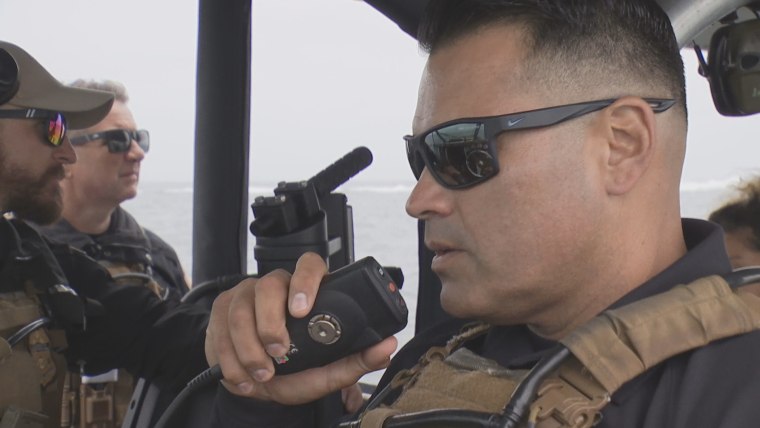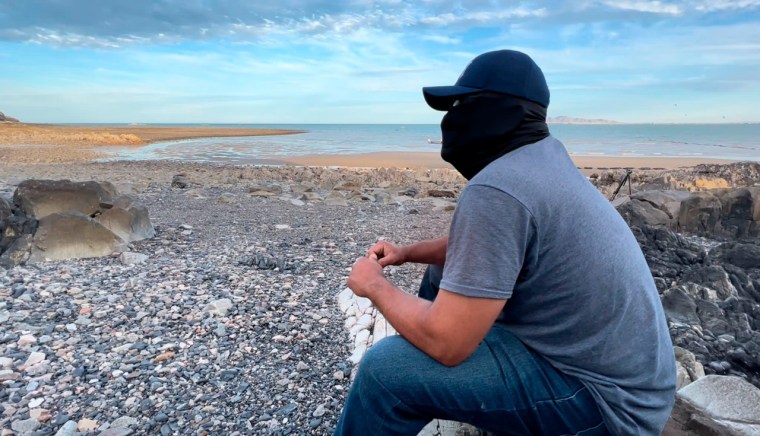BAJA CALIFORNIA, Mexico — The fisherman knows the Pacific Ocean well, having traveled the high seas to catch snapper, sole, grouper and other fish since he was 12 years old.
But for a few years now, his expeditions — as well as those of other veteran Mexican fishermen from Baja California — go well beyond fishing: Recruited by criminal human trafficking networks, they're using their boats to transport a growing number of people who are trying to migrate to the U.S. by water.
“Sometimes you get caught by winds, storms, and you have to take care of the people you’re carrying. They’re crouched with their life vests, and it gets tough — it’s open sea,” said the fisherman, who is not being identified by name; he was imprisoned for a year in the U.S. for illegally transporting people on his boat.
“They caught me [as easily as] taking candy from a child because my engine broke down — I had 7 miles to go when it broke down and I had already seen drones, a frigate and the Coast Guard. I turned off the engines and got them up and I waited for them to come for me," he said, describing when he was caught in U.S. waters. "Since I was transporting 25 people, because of the number, they couldn’t give me six or eight months (in jail). They told me it was 13 months and one day, but they took two months off for good behavior."
According to a Migration Policy Institute report published in May, the U.S. Coast Guard detected migrants trying to enter or successfully entering the U.S. in the Atlantic and Pacific Oceans 14,500 times in fiscal year 2021 — almost double the 7,600 in FY 2020 — though it and other authorities, such as U.S. Customs and Border Protection and foreign navies, made 5,000 interdictions.
In the first seven months of fiscal year 2022, according to the report, the Coast Guard intercepted more Haitians at sea than in any fiscal year since 1994. Nearly 2,000 Cubans at sea have also been recorded intercepted in the same period, more than any fiscal year since 2016, which shows the increase in migratory transit from the Caribbean.
Dangerous but lucrative: 'Never going to end'
Although the fishing boats normally used in the area are made to carry only six people, the fisherman started transporting 15 to 20 migrants and has carried up to 28 or 30 passengers as he navigates the dark seas at night.
“When you are carrying more weight, the engines break down, you drift and that’s when they grab you," he said.
“You see a frigate (of the U.S. Coast Guard or Mexican Navy), you see a light and you have to go very far,” he said, explaining how he works to elude the authorities. “And then you start going in, until you reach land. Around midnight or 1 a.m., you have to be arriving and taking off the boat.”
José María Ramos, an investigator and a professor at El Colegio de la Frontera Norte, an institute in Tijuana that focuses on border issues, said that while land crossings are still the most popular way to migrate from northern Mexico to the U.S., "there are also trips by sea, both through the beaches of Tijuana to go to San Diego, where people even cross with Jet Skis or swimming, which is very dangerous because many times they drown."
It's an important corridor for organized crime networks for drug trafficking and transporting migrants, he said. "Unfortunately for traffickers it's a big deal because, according to the World Bank, the transfer of Mexican migrants alone by human traffickers amounts to $1,648 billion,” Ramos said.

The fisherman agrees with the figures from various international organizations that estimate that the transfer of migrants by sea is one of the most expensive ways to cross into the United States because, on average, the person must pay $15,000 to $17,000 or more than going by land. Garcia makes $1,000 per passenger for himself.
“You can earn about $12,000 or $13,000 per trip, in two rounds it’s $26,000 or 27,000 dollars," he said. "But it’s not much either, because of the risk. You can lose everything, fall in jail."
Still, the risks are worth it — by comparison, fishermen in the area earn an average of $685 a month, which explains why many persist in trafficking people from Mexico to the United States.
“This business is never going to end,” the fisherman said bluntly.
He said he's never met his “patrons"; they usually notify him a few hours before setting sail and he is not present during the preparations with the migrants.
“You get to the shore, and the people are already there because they take them in other cars. They have everything full of gasoline and you just get there, you get on, and let’s go. Before leaving you have to check the weather, the wind, the waves and how big they are going to be, to calculate what time you are going to get there, because you have to get back before dawn,” he explained.
Despite dangers, ‘uniting families’
Although various U.S. organizations, such as the Coast Guard and Customs and Border Protection, have announced that they have expanded their patrol operations along the 114 coastal border miles the two countries share, news of shipwrecks and accidents are increasingly recurrent.
“The sea is one of the most dangerous ways to cross into the United States,” said Alejandro Rentería, supervisor of Customs and Border Protection in San Diego. “The fishing boats are made for five people and fish, and now they’re getting about 15 to 20 people, and it’s very easy for it to overturn.”
Rentería said there’s been an uptick in apprehensions of boats carrying migrants. According to official figures, as of June 1, the total number in the San Diego sector was approximately 370, an increase of approximately 109% compared to fiscal year 2021.
“In almost all the boats that we find, people are wet from the elements, they don’t have food, they haven’t drunk water in hours, sometimes for days,” Rentería said.
In a report last December, the U.N.'s International Organization for Migration warned that it’s very likely that many people who undertake the journey to the United States “without a migratory project or previous migratory experience” may think that crossing the sea is the easiest route. But the researchers warned that “documented experiences show us that these migratory strategies can be highly fatal.”
Meanwhile, the Mexican fisherman said he considers it his job to transport people trying to migrate, adding he takes great risks to help them. In fact, he said, he's “uniting families.”
“We always take care of people because they are human beings like us, they all feel," he said. "They thank us for the good treatment we give them. Without hitting them, without saying bad words. Everything is fine, they are happy."
Different routes, one destination
The International Organization for Migration's report last year, titled "The Sea Inside: Migrants and Shipwrecks at Sea," examined the smuggling of migrants through various maritime areas of Mexico.
Despite scarce official information, the U.N. team detected four large areas with routes in the south, southeast, the Gulf and the north of Mexico that are entry points for foreigners.
To the south, it all starts in Puerto Ocós, Guatemala, where migrants pay $400 to $800 to reach the Mexican towns of Puerto Chiapas, Mázatán and Paredón. From there they usually head to Oaxaca, Salina Cruz or other routes such as Huatulco and Michoacán, the latter being very dangerous because of the intense fighting between the rival factions of the drug cartels.
Then there is the activity in the Yucatán Peninsula, where the entry of people from India, China and Africa, in addition to Cuba and the countries of Central America, has been detected. In that region, the routes used are Cuba to Isla Mujeres; Cuba to Cancún, Mexico; and Belize to Chetumal, usually using fishing boats carrying people from countries such as El Salvador, Guatemala and Colombia.
The third transit zone is Tijuana. The routes that are confirmed go from Rosarito and the beaches of Tijuana to San Diego; there are others like Puerto Nuevo-Chula Vista and Ensenada-Popotla.
In the Gulf of Mexico, considered the stage prior to transiting through Tamaulipas and South Texas, the report's researchers warned that migrants in that area are at risk of being recruited by drug traffickers to transport drugs or commit other illicit activities.
The investigation also detected maritime routes through the Pacific, which include arrival points in the Sea of Cortez at a site known as “El chinaro.” The Mexican towns of Ensenada, Popotla, Maneadero and Salinas are departing points to transport migrants to the U.S.
“You leave Ensenada and you go 100 miles out to sea. From there you go north, like another 50-60 miles, and then you take your course inland to San Juan Capistrano, San Clemente or La Jolla (California). There is a part where a train passes by the edge of the beach, and that helps a lot because you arrive by boat the train engines drown the noise," the fisherman said.
An earlier version of this article was first published on Noticias Telemundo.
Follow NBC Latino on Facebook, Twitter and Instagram.
